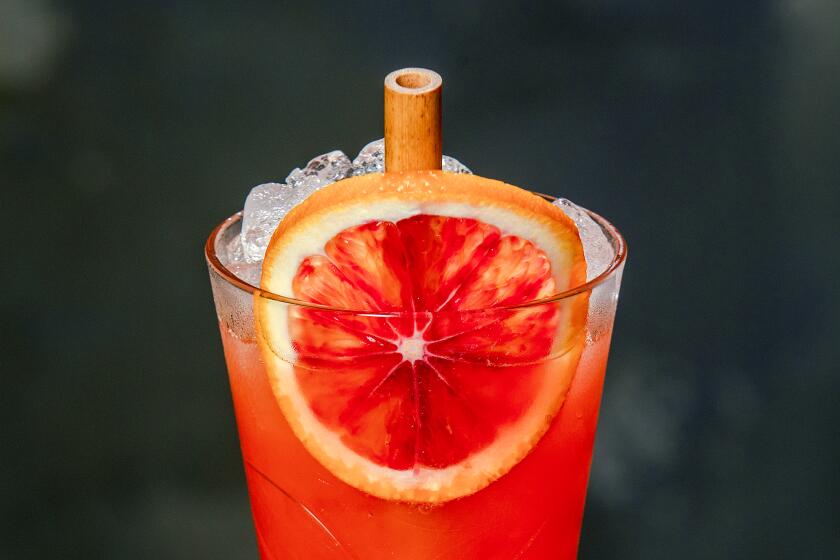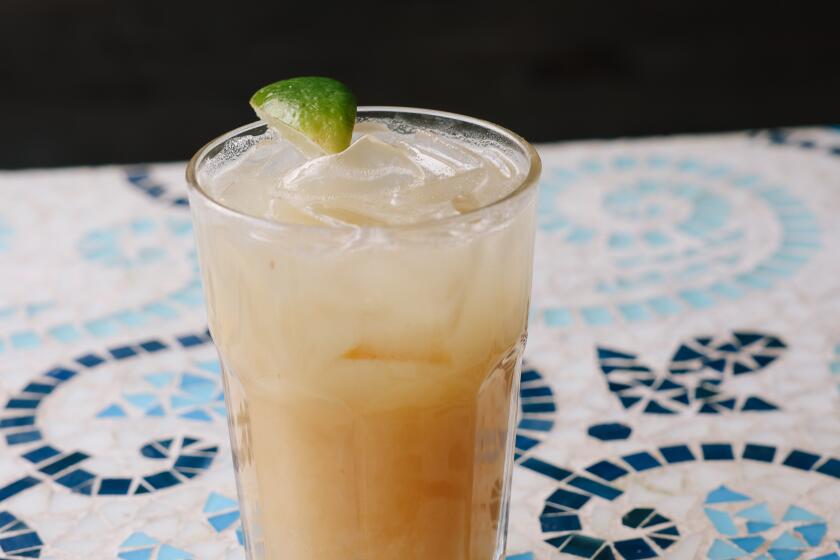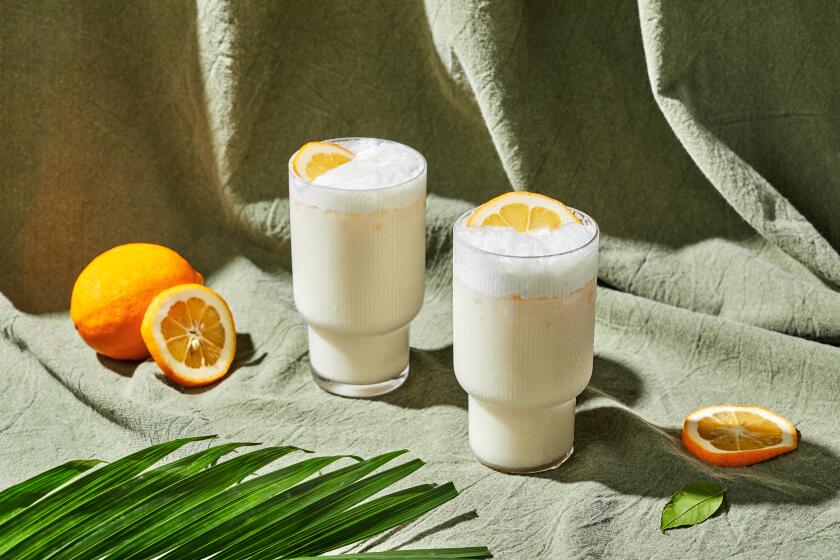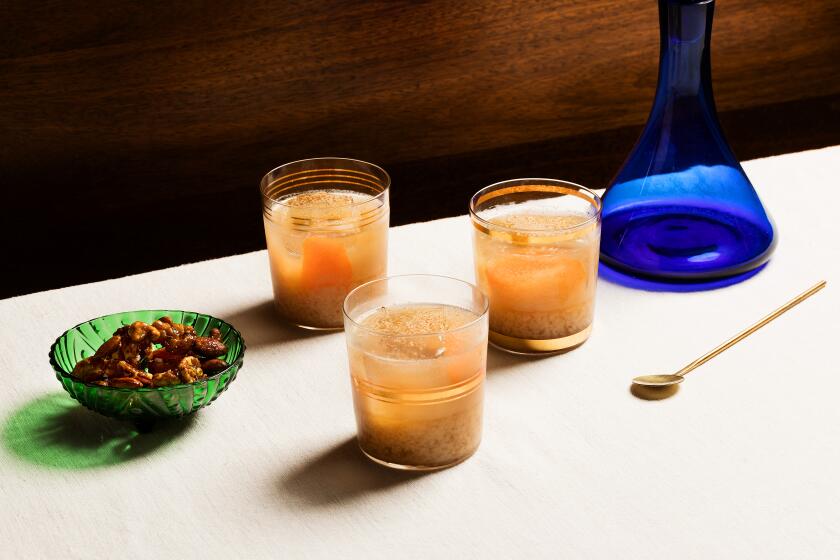White peach-Riesling sangria
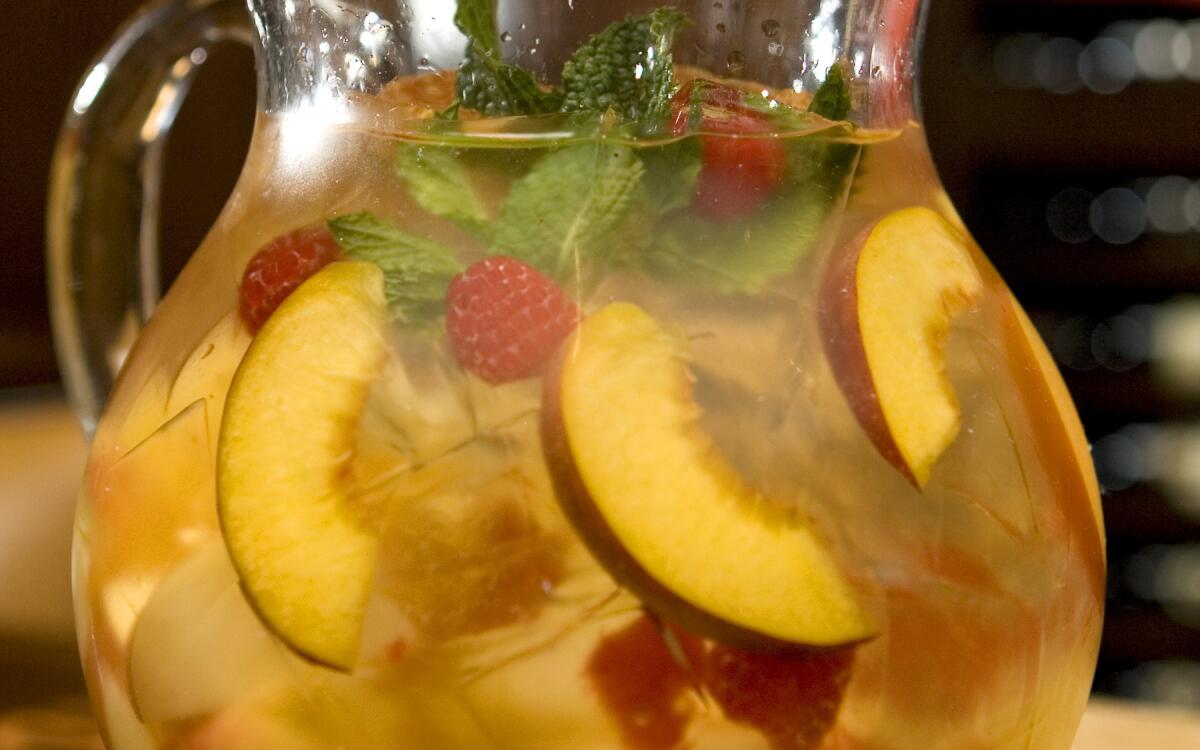
- Share via
Under the olive tree on the patio at Dominick’s, the Italian spot on Beverly Boulevard. Poolside at the Ritz-Carlton Laguna Niguel. Behind the bottles and jars of elixirs and house-made bitters at the bar at Fraiche in Culver City. Sangria, it seems, isn’t just for tapas bars anymore. Where you’d least expect it, it’s making a splash.
What could be more appealing than a big, icy pitcher of juicy, fruity, herbal, deeply flavorful sangria? (Two big icy pitchers?) Yet terrific sangria, sangria with some depth and complexity -- sangria that isn’t just another fruit punch -- is hard to come by.
The white peach-Riesling version at the Ritz-Carlton is pretty nice. Dry Riesling gives it some sophistication. (Its creator, Holly Smith, wine director at Eno, the hotel’s new wine, cheese and chocolate bar, recommends a 2004 Freie Weingartner from the Wachau in Germany or a 2004 Anne Amie Vineyards Riesling from Oregon’s Willamette Valley.) White peaches add a lovely perfume, and fresh vanilla bean lends depth.
Best of all is the way it’s served: Though it comes to you poolside in a plastic cup, it’s filled with ice cubes that have pieces of fresh fruit frozen into them: whole raspberries, tiny wedges of peach and little cubes of melon. It’s gorgeous -- like beautiful fruit suspended in an ice sculpture.
At Dominick’s, general manager Brandon Bossert makes a fairly basic sangria -- for him the key is using decent wine. “It’s all premium wine we serve by the glass,” he says. A little simple syrup, a little Triple Sec, a splash of soda water, lots of fruit, and that’s all there is to it.
Again, the presentation and setting are at least half the fun: It comes to the table in a big (24-ounce) mason jar that serves four, and gets poured into small cocktail glasses. Out on that lovely patio with friends, it’s just the thing to wash down chef Brandon Boudet’s crisp, fried squash blossoms stuffed with ricotta.
But there’s one mixologist in town who has made it his personal mission to elevate the drink. That would be Albert Trummer, Fraiche’s “bar chef.”
Two ways to go
Trummer makes two different sangrias -- a fairly simple (though fabulous) one he makes in about three minutes, and another extremely involved one that requires elaborate equipment, ingredients that take weeks to make, four different spirits and fresh herbs probably not available at your supermarket. A batch takes more than 45 minutes to prepare.
For the simple one, he puts cut strawberries in a glass, adds a few drops of aged balsamic vinegar and a splash of Grand Marnier and muddles it well. Then he adds ice, vodka, wine and a healthy dose of lime juice, and stirs. Delicious. Like Bossert, he makes a point of using quality wine -- a good California Pinot, such as a 2005 Branham from Napa, or even a Saint-Emilion. “Don’t tell the winemaker!” he says.
It’s beautifully balanced, which seems a little odd, given the lime juice. Oh, it’s not just fresh lime juice, he confides, “the limes are fermented with fresh sugar cane.” In fact, he says, he’s about to get a sugar cane press for the purpose. He could stop there -- the drink is wonderful.
But Trummer is just warming up. Now he’s ready to make his serious sangria. He adds ice to a magnum-size decanter, then strawberries, mint leaves and a little fresh lavender. Next -- from the array of house-made elixirs and potions lining the bar -- comes some Knob Creek Bourbon he’s infused with vanilla. (Eight or nine vanilla beans are soaking in the jar, and the concoction is fantastic on its own.) A few drops of house bitters, then something from a bottle labeled “vanilla elixir.” He puts the decanter over a sort of Bunsen burner.
“A good sangria has a Cognac base,” he says. “It needs a little strongness for the body.” To that end, in a small copper skillet, he heats some Hennessy Cognac, along with two kinds of anejo tequila -- El Tesoro de Don Felipe and Sauza Tres Generaciones Cazadores. They don’t call him bar chef for nothing.
He lights it on fire, swirls it around daringly and pours it into the decanter, still aflame. Finally, in goes some of that lime potion. “It’s like a botanical Sidecar,” he says gleefully, warming it up a little. He swirls it and offers a taste.
It’s excellent. Trummer serves it in a wine glass -- no ice. It’s not cold. But it is deep. And complex. It’s so sophisticated in flavor that it works pretty well with an assortment of cheese.
But Trummer’s not done -- now it’s going to “ferment” (by which he means cook very gently) for half an hour or 45 minutes.
In Spain, he says, sangria is simply a matter of putting some spirits in the house wine, which probably isn’t great wine to start with, and maybe some fruit. Then they let it sit at least overnight.
“For me,” he says, “the best sangria is made an hour before.” And a high-quality tequila rounds out the Cognac. “Ten years ago we couldn’t get a good tequila. Now we have 20 or 30 agave ones. I go for the flavor of the blue agave.”
Herbal edge
How did Trummer hit upon tequila in sangria? Disappointed in sangrias he didn’t find very flavorful, he tried spiking his with rum. “And rum kills the wine,” he found. The tequila’s agave, however, adds a compelling herbal edge. Meanwhile, as the sangria continues to “ferment,” a couple at the end of the bar is having some Stage 1 serious sangria (from earlier this batch) with a plate of mussels; they look to be in heaven.
In fact, Trummer’s more elaborate sangria is not something you can always get at Fraiche; Trummer makes it up for parties with advance notice. Otherwise, it’s only when he feels like it.
Forty-five minutes after the sangria went over the flame, he pours a little into a glass, tastes it, smiles hugely and says, “Now it’s perfect!”
Unfortunately, it’s also a case of “don’t try this at home.” Not because it’s dangerous (though it probably is, with those swirling flames) but because you can’t: Though Trummer gave me the recipe, he left out about half the ingredients. What would be the point? Is there anyone who’s prepared to make his own bitters?
So while I was able to make adjustments to his simpler recipe (the strawberry sangria) to allow for the fact that most of us don’t have a sugar cane press, the serious sangria was a pipe dream. I looked and looked for another sangria that might be half as good. It didn’t seem to exist.
And finally, I did what any sensible cook would do: I stole some of Trummer’s ideas to create my own. I used good wine (a Cotes-du-Rhone one time, a crianza Rioja another); gave it a base of Cognac, some added depth with sweet red vermouth, a scraped vanilla bean and Grand Marnier. Brightness came from freshly squeezed orange juice; botanical interest from fresh lavender and mint. And then I tossed in lots of fresh fruit -- ripe peaches and plump blackberries and slices of orange and lime.
OK, I’m no Albert Trummer, but this was good. Let it sit for an hour, pour over ice and imagine you’re on the beach in Valencia, about to dig into a seafood paella, just off the fire.
In a large pitcher, combine the Riesling, cranberry-peach drink, peach nectar, lemon juice, simple syrup, vanilla bean, lemons, oranges, peaches and raspberries and stir gently. Refrigerate several hours, but preferably 2 to 3 days, to allow the flavors to develop.
To serve, pour the sangria into a high-ball or margarita glass filled with ice. If desired, float the top of the glass with a little club soda and garnish with a mint sprig. Serve immediately.
Get our Cooking newsletter
Get a taste of Los Angeles — and the world — with recipes and kitchen tricks from the L.A. Times’ Cooking newsletter.
You may occasionally receive promotional content from the Los Angeles Times.











